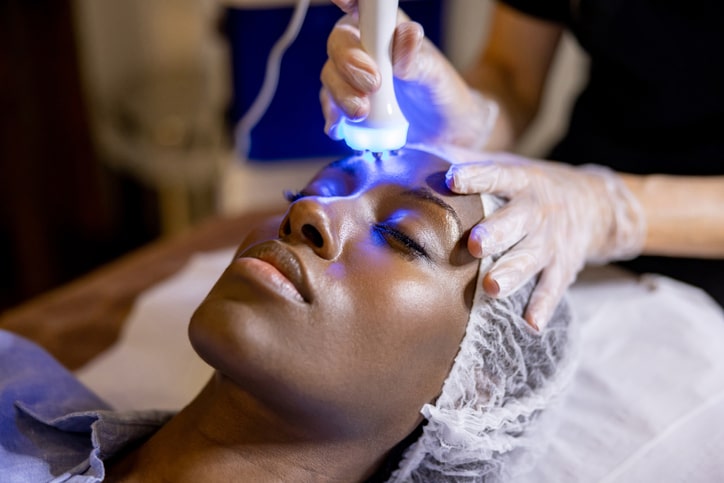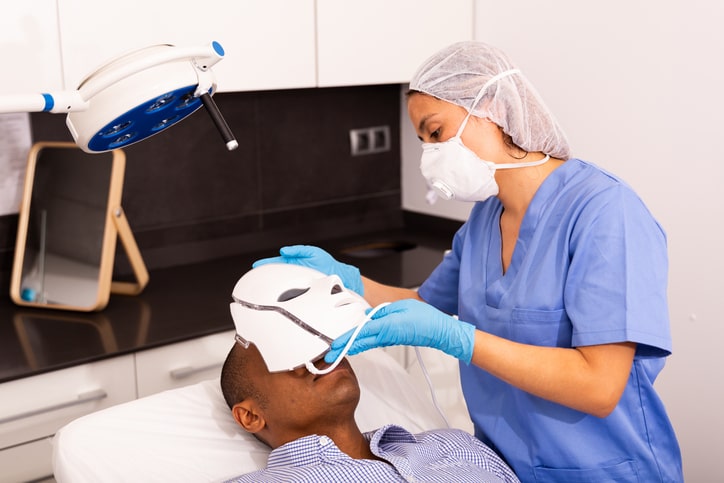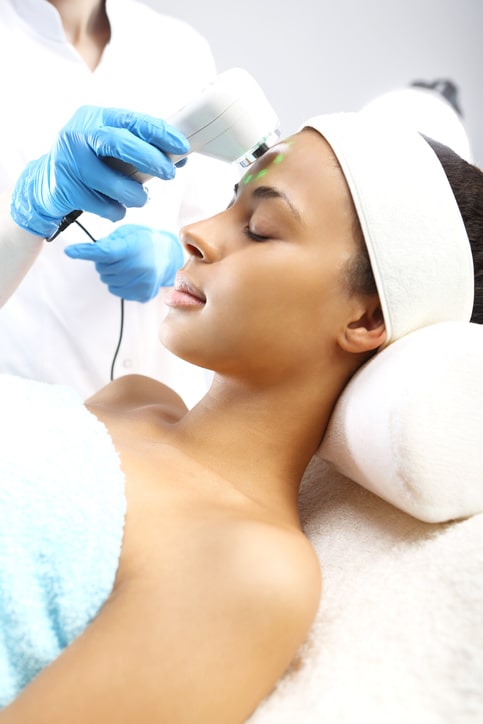Recent Posts
- How to Choose the Correct Silicone Rod or Shield Size for Each Client’s Lashes
- How a Professional Lash Lift Kit Can Boost Your Salon Revenue by $1,000/Month
- Can I Reuse Silicone Rods and Other Lash Lift Tools? A Guide for Beauty Professionals
- How to Start a Pro Lash Lift Business
- How to Tint Eyelash On or Off the Lash Lift Rod
LED Light Therapy for Dark Skin
Posted by Omolola A. on Apr 27, 2022
Dark skin is peculiar for several reasons. First, it contains a generous amount of special melanin known as eumelanin. There is also ample presence of melanosomes, an organelle responsible for the production, storage, and transportation of melanin around the skin. This gives dark skin the strength to withstand UV rays more than any other skin color.
Again, black skin is prone to certain skin conditions such as ashiness, flesh moles, keloids, vitiligo, etc. However, one of the ways to treat some of these skin conditions is by using LED light therapy.
So, if you are a dark African-American or your skin is tanned due to longtime exposure to sunlight, and you are considering LED light therapy for one or more of these conditions, this post is for you. We'll examine what LED light treatment entails and how it may affect people with dark skin. Just relax and let's go!
What is LED Light Therapy?
LED light therapy has been adopted as a treatment method for skin challenges for around two decades. Mostly, people resort to this form of skin treatment when other milder skincare methods have failed.
Light Emitting Diode (LED) light therapy is a non-invasive and non-thermal form of skin treatment. In simple terms, the procedure does not introduce foreign materials into the body or use any form of heat. Instead, it involves permeating the skin layer with lights of varying wavelengths.
These lights themselves do nothing but stimulate the body's immune system to heal itself. The emitted rays also cause some organelles responsible for producing collagen and elastin to do more to meet the body's needs.
Types of LED Light Therapy
There are varieties of LED light therapies. The categorization depends on the light emitted from the LED therapy device. Generally, these include the red, yellow, green, and blue LED light therapy. Each ray color produces different results. Besides, each of them has its unique penetration level into the skin.
Overall, red light and blue light are the most used of the four LED light types. Often, many people combine these two for more efficiency. The blue light destroys acne-causing bacteria underneath the skin surface, while the red light catalyzes healing and recedes inflammation.
Meanwhile, here is a highlight of the four LED light therapies.
Red Light Therapy
Unlike the other three types, red light has the longest wavelength and works superficially. The light can penetrate the skin only by 5mm. So, red light therapy is limited to the topmost layer of the skin. The function of this kind of therapy is anti-aging. By implication, the treatment covers conditions like scars, redness, mild acne, and wrinkles.
While this treatment can be a standalone process, you can also use it in combination or as a follow-up to other LED light therapies.
Yellow Light Therapy
Yellow light travels much deeper into the skin, having a shorter wavelength. As a result, dermatologists recommend it for wound healing. It also helps induce collagen production and enhance skin hydration. Most people opt for this treatment after procedures like microdermabrasion and skin needling treatments.
Green Light Therapy
Green rays travel quite the distance into the skin layers but not as much as blue light does. While this type of LED light therapy is not as common as the latter, it is equally potent in skin restoration. One of its applications includes fading away dark spots on the skin by breaking up melanin clusters (hyperpigmentation).
Blue Light Therapy
Blue rays travel farthest inside the skin layer, even more than UV rays, and can deal with far more concerning and malignant conditions. Examples include sun damage and skin cancer growth of varying levels. Sometimes, you may need to take photosensitivity drugs to enhance the absorption of this ray.
Is it good to Use LED Light Therapy for Dark Skin?
One of the scares of using LED light therapy for dark skin is that it may cause burns, but this is far from true. Even though science tells us that dark surfaces absorb more heat than light ones, this does not apply to LED light therapy because LED light therapy is non-invasive. Therefore, whatever type of LED light you may consider, none generates harmful heat to the body.
Studies also reveal that the reflection of light has nothing to do with the absorption level of the material. Working with this knowledge, we can safely conclude that though dark skin has poor light reflection, the absorption of rays depends on the photosensitive molecules like (porphyrin and flavins) or chromophores in the skin.
Moreover, clinical studies assert that people with dark skin benefit just as much as their counterparts with light skin from LED light therapy. So, while skin variance goes beyond the coloration, there was no significant difference when treating people of different skin colors.
After considering these investigated assertions, we can safely conclude that LED light therapy is safe for dark skin.
Benefits of LED Light Therapy for Dark Skin
The challenges of people with dark skin coloration are not unique to the skin type. That implies that tanned skins can benefit from as many treatments as skins of other colorations enjoy. Some of the benefits of LED therapy for dark skins are as follows:
Promotes wound healing: There are medical proofs that LED light therapy (blue and red) can accelerate wound healing through photobiological response. That means the body is stimulated to secret more fibroblast or collagen that forms the new tissues' foundation to replace the damaged ones.
Ameliorates psoriasis lesions: LED light treatment causes substantial decreases in psoriasis lesions in the skin.
Improves skin complexion: Green light therapy helps even the skin coloration by reducing melanin production in areas where they are in excess concentration.
Diminishes wrinkles: Wrinkles occur on the skin due to the breakdown of collagen and elastin fibers beneath the dermis. Since red light spurs collagen and elastin production, the effect becomes evident as dark skin regains its smoothness and firmness.
Reliefs pain and inflammation: Red light therapy improves blood flow to places with damaged tissue, causing it to regenerate. Studies also show that this treatment can reduce chronic pain substantially.
Reduces scars: Cells exposed to LED Lights are stimulated to produce new blood vessels and fibroblasts (cells that secret collagen protein), causing the formation of new tissues.
Pacifies skin color loss (vitiligo): When the skin begins losing color in small or large patches, melanocytes are absent. For dark skin, this condition is conspicuous because the light skin contrasts widen with areas. Red LED lights could stimulate melanocytes' migration to other areas of the skin, reducing the whiteness.
Treats and prevents acne: tanned skin is prone to this skin disorder, and LED light therapy soothes acne. Blue LED light can reduce the activity of the sebaceous gland. That means less oil production and less clogging of the skin. Again, blue LED light kills acne-causing bacteria.
How often should LED light therapy be used on dark skin?
LED light therapy requires continuous use even after seeing the desired effect. It becomes a regular beauty routine that maintains the healing achieved by the process. We recommend at about fifteen minutes sessions daily. Red light is mild and shouldn't cause any adverse effects with daily use.
You can also use the blue light therapy device for about twenty minutes daily as long as there is a condition to control. However, you should be vigilant to know if your skin is showing some allergy to it. Something to watch out for includes burns, irritation, and inflammations. Stop using it and see your skin specialist if any of the signs show up.
You can get your LED light therapy device for home use to reduce the frequency of visiting a spa or a specialist. Seeing that the process would become a routine, the treatment cost would accrue to a large sum over time. Hence, you should purchase a LED light therapy machine for cost-saving and ease of therapy. Getting a LED light therapy device is not farfetched. You can quickly get it on the most online shopping cart.
How long does it take LED light therapy to work?
LED light therapy doesn't give an instantaneous result. The duration of treatment varies between a week and several months. For example, red light therapy often lasts about twenty minutes, and you would need about ten or more sessions to see results. At some times, you may require around four months.
Blue light therapy sessions require two to five visits fortnightly or monthly. These rays are powerful enough to give some results even after a single session. The estimated time for each session varies between fifteen and nineteen minutes.
Overall, how long Led light treatments would take depends on several factors, and they are:
Skin type
How soon you will begin to see results during therapy depends on your skin type to a large extent. Dark skins, like other skins, vary in response to light from individual to individual. Since LED light therapy works by stimulating the skin's immune system to do the healing, naturally responsive skin would heal faster than others.
Consistency of treatment
Dermatologists schedule therapy times considering the skin condition to treat. Skipping a schedule can make previous ones none effective, thereby delaying the time it takes for the therapy to work. Consistency is the best way to get results quicker in LED light therapy.
Type of LED Light Therapy
The light type has varying effects on the skin. The red light therapy would often take several sessions every week for a couple of months before noticing results. Meanwhile, blue light requires fewer sessions. Some procedures may require only three twenty-minutes-sessions for a week.
Severity of Skin condition
The severity of the skin condition you wish to treat affects the overall time your body begins to respond to treatment. Mild conditions would generally take longer to treat than more serious ones.
The Quality of LED Light Therapy Device
We mean no harm, but all LED light therapy devices are not made the same. That means their quality varies. You should expect this as there are several options in the stores. The treatment coverage area, wavelength, and quality of the device's output are some things you should consider when buying a LED light therapy device.
Best LED Light Therapy for Dark Skin
There is no one-size-fits-all type of LED light therapy for dark skin. If you must use LED light therapy, the skin condition you wish to treat would determine the best type for your dark skin. Here are some skin conditions for black skin and the best LED lights for treatment.
Red light therapy: clearing wrinkles, tissue repair
Blue light therapy: best for sun damage, skin cancer, and acne
Yellow light therapy: best for wound healing, rosacea, redness
Green light therapy: best for clearing dark spots and evening skin coloration
Sometimes, experts use a combination of LED light treatments to solve some skin challenges. So, while each type could be highly effective in certain aspects, using them simultaneously can have a powerful effect. But you should not combine treatments on your prescription. Leave the decision to your dermatologist.
Risks of LED Light Therapy on Dark skin and How To Prevent Them
LED light therapy is reportedly safe for dark skin compared to other types of treatment. There are no burns or interferences with the physical structure of the skin. Notwithstanding, experiments reveal some side effects people may experience while using this skin treatment method.
Side Effects of LED Therapy on Black Skin
Depending on the type of LED light used, some side effects of LED light therapy include:
Dryness: Red light therapy may remove some outermost skin cells, resulting in dryness of the revealed layer.
Changes in skin color: Blue light treatment may induce hyperpigmentation or darkening of the skin. That is because it affects melanin production and could turn it up more than necessary.
Stinging: LED light therapy does not heat the body. But in some instances, the rays may trigger the release of some free radicals that attack tissues.
Redness and inflammation: Although LED light is used for treating skin conditions, the release of free radicals in the skin can exacerbate mild ones, leading to swelling, redness, and inflammation
Eye defects: Medical studies reveal that exposure to LED lights may cause irreversible damage to the retina. These rays may also diminish your vision when you stay long in the LED light machine.
Most often, the side effects of LED light therapy on the skin are not long-lasting and usually resolve after the treatment is over. These side effects are more likely to occur when the patient uses photosensitizing drugs before blue light therapy. However, if these signs persist for long, you should see your skin specialist.
As a caution, people with porphyria must avoid LED light therapy. The skin condition is often genetic, and tanned skin color wouldn't help either. Besides, there are suggestions that the disorder is more rampant among African-Americans.
How to Prevent Side Effects of LED Lights Therapy
Allergies to LED light therapies are rare but not unrecorded. The good side is that most side effects associated with LED light therapy are preventable. You can make the treatment experience safer by adhering to the following tips.
Use of Safety Goggles
We can't overstate how dangerous these light rays are to the eyes. Dermatologists would always give you a pair of safety goggles to protect your eyes from the powerful radiations during LED light therapy sessions. The risk of exposure is higher when you undergo the therapy yourself at home. Since there are now several devices to hold LED therapies at home, there is the danger of being careless about using these goggles. Hence, you must remind yourself to wear safety goggles before using any LED light device.
Don’t forget Serum
Serums are skincare products with concentrated ingredients to meet specific skin challenges. People with dark skin can use serums to enhance the action of LED light therapies. There is no downplaying the latter's effectiveness, but serums like vitamin C work to make the process more potent. Let's say using both complements each other and can help to avoid some side effects.
Use Moisturizers
As already stated, LED light therapy can result in skin dryness. Since there are other benefits from the procedure, you may not have to stop it because of this reaction. Using a moisturizer after LED light therapy would help restore the skin's moisture and help you focus on the benefits of the treatment.
Visit the Best Spa
If you don't know the knack for doing safely, visit the spa. Some spas offer LED light therapy, and you should be visiting one often. But you can't undergo this facial treatment only because the resort has the device. Ensure only an expert is attending to you to prevent the wrong application. But how do you know which spa is best for you? At spreeberry, we'll help you find the best spa near you.
Avoid Overstaying Therapy Time
LED light therapy time is not one for relaxing. It is pretty easy to take such periods as a nap time, especially when lying under the machine. While this is not likely in a spa or with your doctor, the same can't be said of home treatments. Staying beyond the prescribed time can cause the body to react adversely. After all, too many good things could become harmful.
Inform your Doctor of any Health Conditions
LED light therapies are generally safe, but people with some skin and medical conditions would not be allowed to go through them. Your dermatologist would ask you some questions to know your health history before placing you on LED light therapy. Answer then sincerely to help them discern if you are okay with the therapy.
Meanwhile, the following people should not undergo LED light therapy:
People that are on medications that increase sensitivity to sunlight. Examples of such prescriptions include antihistamines, sulfonamides, psoralens, and sulfonylureas.
Anyone with certain medical challenges such as chronic eye disease, skin cancer, and porphyria.
Going ahead with the therapy will birth many things. But the most disheartening one is that the therapy may aggravate the condition. And, of course, you will spend more time and money treating the ailment than before.
Summary
LED light therapy is fast becoming a popular option among many people. The good part is that the effect of this beauty process is not biased by skin coloration. Hence, dark skins benefit from it as much as their white peers.
Several health agencies approve the use of LED light therapies due to their relative safety. For one, there is no UV ray in LED lights. Although there are some side effects to the methods, we must clarify that they happen rarely. That means you should not be scared of the therapy.
Furthermore, you should see your doctor before opting for LED light therapy. They would help you diagnose your skin condition and recommend one for you. An assumption wouldn't cut it.
Also, LED therapy devices are available for use at home. That means people could abuse them. As noted earlier in the article, too much exposure to these rays could spell danger to the user. You must adhere strictly to the instruction manual of these devices.
Lastly, the effectiveness of LED light therapies varies among individuals. Recall that the process is as natural as possible, so much of the healing depends on your body's response. In the end, consistency and patience would be your greatest allies if you would get results from LED light therapies.




